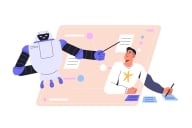You have /5 articles left.
Sign up for a free account or log in.
The COVID-19 pandemic will be around for a while. Eventually, there will be a vaccine that allows us to resume a far more normal life. (Bring back baseball!) But until we have an effective, widely available vaccine, it seems clear that the keys to successfully restarting our economy are testing, tracing and social distancing.
Testing of course depends entirely on the ready availability of high-quality tests. We are not there at present, but at some point in the near future, we will be. Distancing will, in the end, be up to each and every one of us. Sure, governments can and will lay down rules and guidelines, but it will be up to individual citizens to observe the letter and spirit of the guidelines. Most will, some will not.
But contact tracing -- identifying individuals infected with the virus and finding everyone they have been in contact with -- is neither a technical, scientific question nor a matter of human behavior. It is hard, essential, unglamorous, labor-intensive work. It will require a lot of people to do it right. Indeed, a Johns Hopkins University report on a national COVID-19 contact tracing program estimated that, “as a start,” 100,000 or more people need to be hired nationwide to conduct the type of contact tracing that will keep a lid on the infection, identifying an outbreak at its source before it has a chance to spread to a wider population.
This is where we think higher education and our students can step in to carry out an invaluable public good.
One way to create and quickly expand the nation’s contact tracing capacity would be for states -- using some of the federal stimulus money that they have already received -- to establish a Contact Tracing Student Corps in cooperation with each state’s colleges and universities and in collaboration with public health agencies. Run by the states, this would not necessitate the creation of a new federal program or expansion of an existing one. The ball would be in the capable hands of state governments.
Students would enlist in the corps by taking semester-long courses on their campuses that are structured as service learning or experiential classes. Their training in contact tracing would be under the supervision of the public health agencies and, under the guidance of those same agencies and each participating school’s faculty, they would take to the field and implement the protocols to help with this vitally important and time-consuming task. Students would receive course credit paid for by the state through the federal stimulus funds and would conduct the contact tracing as part of the course. This would, of course, mean some additional, albeit modest, financial support for the students’ institutions: a good investment for public health, for students and, lastly, for colleges and universities.
This student corps would be a part of the solution that could save states and local health departments both money and effort in carrying out the contact tracing needed to reopen our society safely. By providing funds to allow universities to conduct the courses, the state would both limit the need to hire and manage payroll for thousands of individual contact tracers and avoid creating a tax liability for the students. It would also engage relevant faculty, who can serve as a layer of management and quality control for the work.
The courses could begin as early as midsummer and run each semester thereafter until there is a vaccine or effective treatments in place and there is no longer a danger of potential widespread outbreaks. Universities could adapt their specific courses to suit the academic needs of their students, some of whom missed out on their summer internship opportunities to meet their experiential learning requirements.
Make no mistake. No group of students, no matter how large or idealistic, will be able to provide the full array of contact tracing the nation will need. And, of course, they will lack the expertise and experience to completely interpret the data they help collect. However, they can become a valuable part of the army of people we will need to help reopen America. Indeed, the greatest benefit of such a corps may be its ability to help small, understaffed rural communities and fiscally strapped cities that would otherwise struggle to stand up their own tracing teams.
For students, this experience would provide the opportunity to serve the nation in a time of need and explore an extraordinarily important part of American life -- the U.S. public health system. And there should be no doubt that, having been given this opportunity, some of the students would consider careers as doctors, nurses and public health specialists.
The work would be tough, sometimes tedious and always important. But there is a strong tendency toward idealism in America’s youth. From the armed forces to the Peace Corps to Vista and the National Health Service Corps, young college students have repeatedly stepped forward to answer the call when they were needed.
We have seen it time and again -- when the nation is challenged, students are often willing, indeed, eager, to find a way to help. COVID-19 is unfortunately likely to be with us for some time. All of us will need to do our part. Statewide Contract Tracing Student Corps could help give college students a central role in meeting the great challenge of our time.








